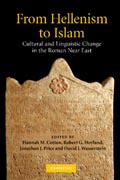
From Hellenism to Islam: Cultural and Linguistic Change in the Roman Near East
Cotton, Hannah M.
Hoyland, Robert G.
Price, Jonathan J.
Wasserstein, David J.
The eight hundred years between the first Roman conquests and the conquest of Islam saw a rich, constantly shifting blend of languages and writing systems, legal structures, religious practices and beliefs in the Near East. While the different ethnic groups and cultural forms often clashed with each other, adaptation was as much a characteristic of the region as conflict. This 2009 volume, emphasizing the inscriptions in many languages from the Near East, brings together mutually informative studies by scholars in diverse fields. Together, they reveal how the different languages, peoples and cultures interacted, competed with, tried to ignore or were influenced by each other, and how their relationships evolved over time. It will be of great value to those interested in Greek and Roman history, Jewish history and Near Eastern studies. INDICE: Introduction Fergus Millar; Part I. The Language of Power: Latin in the Roman Near East: 1. The presence, role and significance of Latin in the epigraphy and culture of the Roman Near East Werner Eck; 2. Latin in cities of the Roman Near East Benjamin Isaac; Part II. Social and Legal Institutions as Reflected in the Documentary Evidence: 3. Euergetism in Josephus and the epigraphic culture of first-century Jerusalem Seth Schwartz; 4. Legal and social status of threptoi and related categories in narrative and documentary sources Marijana Ricl; 5. Ritual performances of divine justice: the epigraphy of confession, atonement, and exaltation in Roman Asia Minor Angelos Chaniotis; 6. Continuity of Nabataean law in the Petra papyri: a methodological exercise Hannah M. Cotton; Part III. The Epigraphic Language of Religion: 7. 'Languages' and religion in second-fourth century Palestine. In search of the impact of Rome Nicole Belayche; 8. The epigraphic habit and the Jewish diasporas of Asia Minor and Syria Walter Ameling; 9. Religion and language in Dura-Europos Ted Kaizer; Part IV. Linguistic Metamorphoses and Continuity of Cultures: 10. On the margins of culture: the practice of transcription in the ancient world Jonathan Price and Shlomo Naeh; 11. Edessene Syriac inscriptions in late antique Syria Sebastian Brock; 12. Samaritan writing and writings Dan Barag; 13. The Jewish magical tradition from late antique Palestine to the Cairo Geniza Gideon Bohak; Part V. Greek into Arabic: 14. The Nabataean connection of the Benei Hezir Axel Knauf; 15. Greek inscriptions in transition from the Byzantine to the early Islamic period Leah Di Segni; 16. Arab kings, Arab tribes and the beginnings of Arab historical memory in late Roman epigraphy Robert Hoyland; 17. Greek, Coptic, and the 'language of the Hijra': rise and decline of the Coptic language in late antique and medieval Egypt Sebastian Richter; 18. 'What remains behind': Hellenism and Romanitas in Christian Egypt after the Arab conquest Arietta Papaconstantinou.
- ISBN: 978-1-107-40395-6
- Editorial: Cambridge University Press
- Encuadernacion: Rústica
- Páginas: 512
- Fecha Publicación: 12/01/2012
- Nº Volúmenes: 1
- Idioma: Inglés
